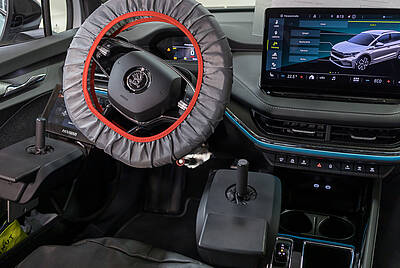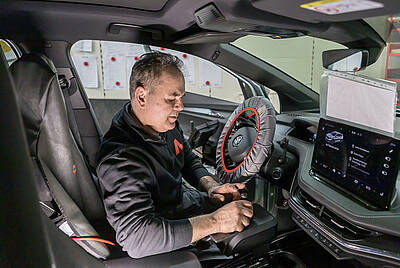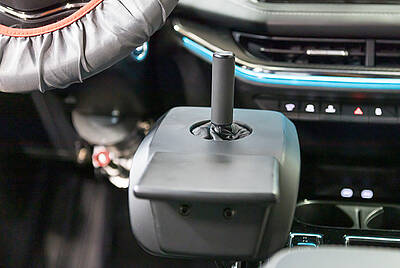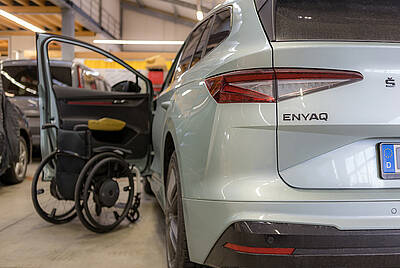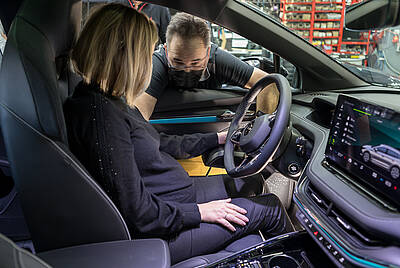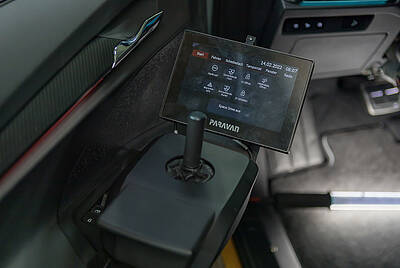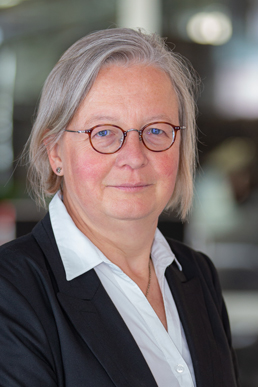All-electric vehicle conversion with Space Drive and joysticks for steering and accelerator/brake - challenges and advantages
"Actually, the conversion is not much different from that of a combustion engine," reports PARAVAN technician Daniel Haberbosch, who specializes in the handicapped-accessible conversion of passenger cars. Especially there, very sophisticated and individual solutions are always in demand. "However, you should always be aware that you are working on an electric car. There it goes above all around clearly more care to ensure the own security as well as with the examination of the electrical devices." To be able to work on a battery-powered vehicle (BEV), you need the expert certificate for working on high-voltage vehicles. All PARAVAN technicians who are entrusted with such work have this. In the meantime, electric vehicles from Mercedes, Peugeot, Tesla, BMW and Volkswagen, among others, have been converted.
The on-board power supply is 12 volts, as in the case of combustion vehicles, and Space Drive is still powered by this supply. Energy consumption is minimal, unlike conventional steering. In addition, there is also the backup battery in case the power supply is disrupted. The only peculiarity is that the electric car does not have a starter motor. To put the Space Drive system into operation, the car sends an appropriate signal to the system via the software in the control unit. In this area, the Space Drive software has been adapted to the special features of the electric drive.
"There should be no loss of range due to steering," says Daniel Haberbosch. "There is no quiescent current. When the CAN bus, which is responsible for reliable data transmission in the car, is switched off, the PARAVAN system also automatically goes into standby mode." The Space Drive team came to the same conclusion when it participated in the ADAC 24h e-competition at the Hockenheimring in February with a VW ID3. There, one fully electric vehicle with Space Drive and a second with conventional steering were used as a reference.
The Robot 3000 Maximum electric wheelchair loading system is another external current collector installed in the vehicle. The loading aid ensures that Svenja Gluth can not only travel from A to B, but can also be mobile on the road without outside assistance. For the young mother, it is the second adapted car and the first PARAVAN.
Often, retrofitters reach their limits when adapting larger electric vehicles with the payload of 3.5 tons, when a cassette lift, electric wheelchair or a transfer console has to be on board. This could be remedied by a similar regulation, which has already been applied to commercial vehicles in Germany since 2019 (Driver's License Ordinance (FeV) §6): according to this, holders of a B driver's license are entitled to drive vehicles with alternative propulsion, such as electricity or hydrogen, with a permissible gross weight of 4.25 tons. If this regulation were to be applied to mobility for the disabled, customers as well as PARAVAN GmbH and other vehicle converters would be greatly helped. In order to find a sustainable solution, however, the problem would have to be clarified at the European level. Installing a cassette lift is also sometimes difficult because an electric vehicle has less ground clearance and the battery is attached to the underbody.
In Svenja's conversion, payload is not a major consideration. She will be driving with the Space Drive drive-by-wire system. She will steer with her right hand using a joystick, and operate the gas and brake with her left hand, also using a joystick. To ensure that everything runs smoothly during the adaptation, the positions of the input devices were already precisely measured on delivery and the primary functions, such as lights, power windows, horn or sun visor, were selected for voice control. Svenja will soon be coming to Pfronstetten-Aichelau and will then be able to take delivery of her new electric vehicle at PARAVAN.
